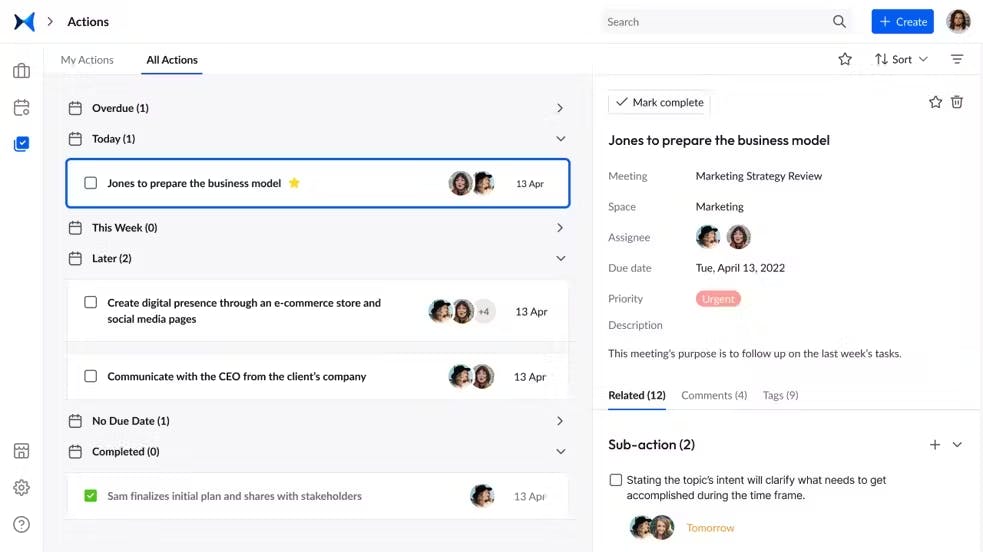Published February 12, 2024
-
9 mins read
Is Your Business an Association or Organization? Know the Difference

Shaimaa Badawi

The distinction of a business as an association or organization is more than academic; it directly influences its operational dynamics and success.
Both terms refer to collective entities, yet their true measure of effectiveness lies in their governance—specifically, the quality of their board meetings.
A deep dive into the nature, goals, and meeting practices of these entities sheds light on how they confront challenges and seize opportunities. Let's find out the differences and similarities between associations and organizations.
What is an association?
An association is a collective of individuals united by shared interests, goals, or professions, working collaboratively to achieve common objectives. Governed by a board of directors or a core committee, associations operate within a formal structure to organize activities, manage operations, and promote their cause, ranging from cultural and educational to professional sectors.
To be recognized legally and benefit from non-taxable status, associations must comply with specific regulatory requirements. This includes documentation and organizational structure, as outlined by entities like the IRS. Board members must understand these regulatory aspects, alongside strategic planning and member engagement, to fulfill their fiduciary responsibilities and enhance the association's objectives.
Why create an association?
Creating an association offers a multitude of benefits that enhance both the professional growth and market presence of its members. Here are the key advantages:
- Associations provide members with opportunities for academic and professional training in crucial areas like marketing and media management, elevating their competitiveness and market prestige.
- Members gain early access to vital market news and trends, allowing them to stay ahead of the competition by anticipating market shifts and learning about new products through shared knowledge.
- Associations often receive better support from banks, facilitating easier access to loans or financing for their members, alongside negotiating deals with vendors for significant cost savings.
- Membership in an association can significantly boost a company's reputation, fostering trust among clients and promoting a commitment to excellence, thus enhancing the company's standing in the market.
Is an association a non-profit?
While associations are more commonly known to be non-profit, that is not always the case, with ones existing that operate on a for-profit basis, like trade associations.
Similarly, not all organizations are for-profit. There are non-profit organizations that maintain formal structures and hierarchies, exemplified by institutions such as universities and hospitals.
This indicates that the distinction between non-profit and for-profit is not strictly tied to whether an entity is labeled as an association or an organization, but rather depends on the specific operational model and objectives of each entity.
What is an organization?
An organization embodies a collective of individuals united by a shared purpose, operating within a structured framework to attain specific goals. It encompasses a variety of entities, including corporations, non-profits, and government bodies, each with its unique scale, goals, and operational procedures.
Organizations prioritize strategic planning and task distribution to efficiently coordinate efforts toward their aims. For board members, a deep understanding of an organization's structure and governance is crucial for effective leadership and compliance with legal requirements.
Pro Tip. Use an all-in-one meeting management platform, like adam.ai, that empowers board members to lead with efficacy, aligning organizational practices with its mission and goals.
Why create an organization?
Creating an organization brings several advantages that are instrumental in fostering growth and optimizing operational efficiency:
- Organizations are adept at crafting and executing strategies that propel growth and improve market positioning. The success of these strategies lies in their clear definition and collective adoption by all members, ensuring unified efforts towards common goals.
- By promoting inclusivity and fostering good communication, organizations create an environment where staff members feel valued and motivated. This sense of belonging leads to increased productivity and advancement within the company.
- Organizations ensure that each member is assigned specific functions upon joining. This clarity in roles enhances focus and dedication, contributing to an efficient division of labor and the successful achievement of objectives.
- Achieving goals requires well-established processes and clear organizational structures. Organizations maintain order in goal pursuit, allowing for the smooth and effective execution of strategies.
What is the purpose of associations and organizations?
The primary purpose of organizations and associations diverges significantly based on their foundational goals and operational focus.
Organizations are primarily established with the aim of generating profit, focusing on activities that directly contribute to their financial objectives. Through endeavors such as production, sales, and marketing, they seek economic growth, positioning themselves as key contributors to the economic sector.
In contrast, associations are formed with a service-oriented approach, prioritizing the needs and interests of a specific community or industry over financial gain. Their commitment is to provide support, advocacy, and enhancement for their members, often through organizing educational events, offering resources, and championing the rights and standards of the profession or group they represent.
What is the difference of association and organization?
Understanding the distinctions between associations and organizations is key to recognizing their unique structures, purposes, and operational mechanisms. Here are the main differences between associations and organizations:
1. Structure and formality
- Association: Features a less formal and more flexible structure, allowing for adaptability in operations and governance.
- Organization: Boasts a more formal and structured setup, with well-defined roles and functions for members.
2. Purpose and focus
- Association: Primarily focuses on advocacy, networking, and the collective interests of its members, typically operating as a non-profit.
- Organization: Aims at service delivery and operations, with objectives ranging from profit generation to fulfilling specific missions.
3. Membership and participation
- Association: Membership is voluntary or by invitation, with an open-door policy allowing individuals to join through contributions or fees.
- Organization: Membership can be through voluntary association or employment, indicating a direct impact on individuals based on the entity's performance.
4. Legal status and funding
- Association: Generally recognized as a non-profit entity, funded through membership fees and donations.
- Organization: Can be either profit or non-profit, with funding coming from the products and services offered.
5. Size and scope
- Association: Typically smaller in size, composed of members with shared interests or goals.
- Organization: Varies in size from small entities to large corporations or government departments, encompassing a wide range of activities and purposes.
6. Liability and profit distribution
- Association: Members do not share liability for losses and have a say in the distribution of profits, if any.
- Organization: Members may be directly affected by losses and have rights in determining the distribution of profits.
7. Examples
- Association: Societies, clubs, professional associations, and advocacy groups.
- Organization: Government departments, businesses, and large entities like the WHO or UN.
What are the similarities between associations and organizations?
Despite their differences, associations and organizations share a set of core similarities that underscore their foundational structure, operational mechanisms, and governance models. Let's outline these similarities:
1. Collective purpose
Both entities are initiated and sustained by a group of individuals united by shared goals or aspirations, highlighting the importance of collective effort.
2. Meeting regularity
Members of organizations and associations convene on a regular basis to discuss progress, challenges, and strategies to advance their common interests.
3. Leadership structures
They both employ leadership models that may either designate specific leaders or adopt shared leadership responsibilities.
4. Profit mechanisms
They possess the ability to generate profit; for non-profits, these profits are reinvested to further their missions.
5. Membership models
Both feature mechanisms for engaging individuals, whether through voluntary participation or mandatory involvement, enriching their activities and services.
6. Legal recognition
Associations and organizations have legal status that legitimizes their existence and activities, operating within a structured legal framework.
7. Management teams
They are governed by dedicated management teams responsible for decision-making and ensuring the smooth execution of operations.
8. Structured governance
Both establish formal governance structures, including procedures and regulations, to ensure organizational stability and efficacy in achieving objectives.
Why are effective board meetings crucial for your association or organization?
Effective board meetings are significant for both associations and organizations, acting as a cornerstone for strategic governance and decision-making. Here's why they are crucial:
1. Strategic alignment: They foster unity among board directors and senior management regarding the entity's mission, vision, and strategic goals, enhancing cooperative efforts towards common objectives.
2. Strategic planning: Board meetings serve as a vital forum for deliberating and refining strategic plans, leveraging diverse perspectives to enrich decision-making quality.
3. Performance oversight: They enable the board to monitor the entity's performance, operations, and risk management, ensuring compliance with legal and ethical standards.
4. Accountability: These meetings hold senior management accountable, safeguarding the interests of shareholders and stakeholders, and ensuring responsible management.
5. Communication: They facilitate essential communication between the board and management, keeping all parties informed about significant developments affecting performance.
6. Decision-making: Board meetings provide a structured environment for making informed decisions crucial to the entity's future, involving key stakeholders in the process.
How adam.ai can empower you to run efficient board meetings
adam.ai is an all-in-one meeting management platform that empowers you to capture meeting knowledge and manage your entire board meeting lifecycle before, during, and after meetings.
Here's what you can do with adam.ai:
1. Sync all your calendars on one platform and create unlimited booking pages to show your availability to attendees for easy scheduling.

2. Record agenda items, actions, polls, decisions, and notes using a smart note-taking system displayed side by side with the built-in video-conferencing feature for enhanced collaboration and productivity, with the ability to integrate with popular video-conferencing tools you're familiar with.

3. Choose a customizable meeting agenda template from our gallery to kickstart preparation for your meetings for maximum productivity.

4. Track your actions to ensure task ownership and accountability and improve decision-making with a powerful follow-up system and the ability to search for actions across all meetings.

5. Categorize meetings into spaces, including project, team, board, and committee, and have all their content under a specific umbrella for easy access.

6. Generate and share meeting minutes for due diligence and to keep a record for future reference.

7. Ask Adam the AI Assistant to generate meeting transcripts, enhance your meeting content, suggest agendas, and highlight action items and key insights.

Get started right now to experience the true meaning of all-in-one meeting management.
The bottom line
By now, you know whether your business is an association or organization. By examining associations and organizations, we uncover a universal truth: the pivotal role of board meetings.
For both types of entities, these meetings are the strategic core where visions are aligned and decisive actions are taken. The adoption of sophisticated meeting management technologies is not optional but essential, offering a pathway to improved efficiency and decision-making.
And while there may be multiple meeting management solutions available, here is why adam.ai is the all-in-one meeting management platform you can trust:
- adam.ai is one of Atlassian Ventures' portfolio companies.
- In the meeting management software category on G2, adam.ai has been ranked a leader and a high performer for successive quarters in the past years.
- adam.ai has been included in the Forrester Report in the AI-enabled meeting technology landscape.
- adam.ai is trusted and used by powerful teams and organizations worldwide for all types of critical meetings, like board, committee, project management, and business development meetings.
- And most importantly, adam.ai integrates with your existing workflow, is SOC2 compliant, provides dedicated support and success, and has a free trial option.
About the author ...
Shaimaa Badawi is an Inbound Marketing Specialist at adam.ai. Her research revolves around meeting management, project management, and board meetings, where she identifies the most daunting meeting pain points that C-level executives, board and committee members, corporate secretaries, and other professionals working in enterprises face in meetings. Based on her findings, Shaimaa provides solutions for inefficient meetings, defines various aspects of corporate-level meetings, and outlines best practices on how to run effective meetings.
Recommended for you

Filing Articles of Incorporation: Why Your Business Needs It
Read now

Editable Board Meeting Minutes Template + Do's & Don'ts
Read now

Why Board Management Software Is Essential for Successful Managers
Read now
Subscribe to our blog
Subscribe to our blog
Get the latest blog posts sent straight to your inbox.
